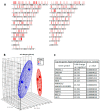Methylation of SPARCL1 Is Associated with Oncologic Outcome of Advanced Upper Urinary Tract Urothelial Carcinoma
- PMID: 30987093
- PMCID: PMC6480388
- DOI: 10.3390/ijms20071653
Methylation of SPARCL1 Is Associated with Oncologic Outcome of Advanced Upper Urinary Tract Urothelial Carcinoma
Abstract
Advanced upper urinary tract urothelial carcinoma (UTUC) is often associated with poor oncologic outcomes. The secreted protein acidic and rich in cysteine-like 1 (SPARCL1) protein, belongs to the SPARC-related family of matricellular proteins. Much literature has been published describing the role of SPARCL1 in the prognosis many cancers. In this study, methylated promoter regions in high-grade and high-stage upper urinary urothelial tumours compared with normal urothelium were analyzed and revealed that SPARCL1 was the most significantly hypermethylated gene in UTUC tissues. Then we prospectively collected UTUC samples and adjacent normal urothelium for pyrosequencing validation, identifying significant CpG site methylation in UTUC tissues. In addition, SPARCL1 RNA levels were significantly lower in UTUC samples. Multivariate Cox regression analysis from 78 patients with solitary renal pelvic or ureteral pT3N0M0 urothelial carcinomas revealed that only negative SPARCL1 expression and nonpapillary tumour architecture were independently associated with systemic recurrence (p = 0.011 and 0.008, respectively). In vitro studies revealed that the behaviour of BFTC-909 cells was less aggressive and more sensitive to radiation or chemotherapy after SPARCL1 overexpression. Thus, SPARCL1 could be considered as a prognostic marker and help decision-making in clinical practice.
Keywords: SPARCL1; upper urinary tract urothelial carcinoma.
Conflict of interest statement
The authors declare no conflict of interest.
Figures




References
-
- Krabbe L.M., Eminaga O., Shariat S.F., Hutchinson R.C., Lotan Y., Sagalowsky A.I., Roman J.D., Wood C.G., Weizer A.Z., Rosicgno M., et al. Postoperative nomogram for relapse-free survival in patients with high grade upper tract urothelial carcinoma. J. Urol. 2017;197:580–589. doi: 10.1016/j.juro.2016.09.078. - DOI - PubMed
-
- Leow J.J., Martin-Doyle W., Fay A.P., Mahmud A., Brundage M., Leveridge M.J., Hanna T.P. A Systemic review and meta-analysis of A systematic review and meta-analysis of adjuvant and neoadjuvant chemotherapy for uppertract urothelial carcinoma. Eur. Urol. 2014;66:529–541. doi: 10.1016/j.eururo.2014.03.003. - DOI - PubMed
-
- Kaag M.G., O’Malley R.L., O’Malley P., Godoy G., Chen M., Smaldone M.C., Hrebinko R.L., Raman J.D., Bochner B., Dalbagni G., et al. Changes in renal function following nephroureterectomy may affect the use of perioperative chemotherapy. Eur. Urol. 2010;58:581–587. doi: 10.1016/j.eururo.2010.06.029. - DOI - PMC - PubMed
-
- Hu H., Zhang H., Ge W., Loera S., Chu P., Chen H., Peng J., Zhou L., Yu S., Yuan Y., et al. Secreted protein acidic and rich in cysteines-like 1 supresses aggressiveness and predicts better survival in colorectal cancers. Clin. Cancer Res. 2012;18:5438–5448. doi: 10.1158/1078-0432.CCR-12-0124. - DOI - PubMed
MeSH terms
Substances
LinkOut - more resources
Full Text Sources
Research Materials
Miscellaneous

